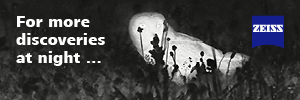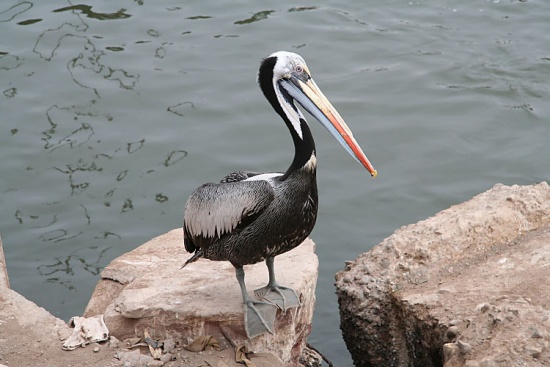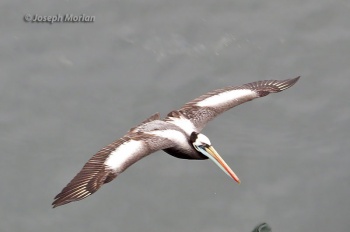m (typo) |
(→External Links: Expanded GSearch) |
||
| (12 intermediate revisions by 5 users not shown) | |||
| Line 1: | Line 1: | ||
| + | [[Image:Peruvian_Pelican.jpg|thumb|550px|right|Adult in breeding plumage<br />Photo © by {{user|Alastair+Rae|Alastair Rae}} <br />Arica, [[Chile]], November 2005]] | ||
'''Alternative names: Chilean Pelican or Chilean Brown Pelican''' | '''Alternative names: Chilean Pelican or Chilean Brown Pelican''' | ||
;[[:Category:Pelecanus|Pelecanus]] thagus | ;[[:Category:Pelecanus|Pelecanus]] thagus | ||
| − | |||
==Identification== | ==Identification== | ||
Dark with a white stripe from the top of the bill, up to the crown and down the sides of the neck. They have long tufted feathers on the top of their heads. | Dark with a white stripe from the top of the bill, up to the crown and down the sides of the neck. They have long tufted feathers on the top of their heads. | ||
| + | [[Image:PeruvianPelicanIMG 9836.jpg|thumb|350px|right|Adult in flight<br />Photo © by {{user|jmorlan|Joseph Morlan}}<br />Port of San Martin (Pisco), [[Peru]], 15 December 2017]] | ||
| + | ====Similar Species==== | ||
| + | Much larger than the similar [[Brown Pelican]] with differences in especially bare part colors. | ||
==Distribution== | ==Distribution== | ||
[[Peru]] and [[Chile]]. | [[Peru]] and [[Chile]]. | ||
==Taxonomy== | ==Taxonomy== | ||
| − | This is a monotypic species. Howard & Moore treat this species as a part of [[Brown Pelican]], but the Opus follow Clements and Sibley & Monroe in splitting it. | + | This is a [[Dictionary_M-S#M|monotypic]] species<sup>[[#References|[2]]]</sup>. |
| + | |||
| + | Howard & Moore treat this species as a part of [[Brown Pelican]], but the Opus follow Clements and Sibley & Monroe in splitting it. | ||
==Habitat== | ==Habitat== | ||
| − | + | Beaches, cliffs and guano islands | |
| + | |||
==Behaviour== | ==Behaviour== | ||
| − | 2-3 eggs are laid and incubated for 4-5 weeks. | + | ====Actions==== |
| + | Peruvian pelicans feed by diving into the water from flight. During coastal bird watching tours between from Pucusana port to Asia Island in [[Peru]]. They can be observed regularly in common feeding frenzies with sea lions, dusky dolphins, [[Guanay Cormorant]]s, [[Peruvian Booby|Peruvian Boobies]], [[Inca Tern]]s and several gull species. | ||
| + | ====Breeding==== | ||
| + | 2-3 eggs are laid and incubated for 4-5 weeks. Breeds in large colonies on rocky coasts, feeding in shallow offshore waters along the coast on small schooling fish. | ||
| + | ====Diet==== | ||
| + | This bird feeds on several species of fish. The main prey species is the Peruvian anchovies (''Engraulis ringens''). Other species consumed are Sardines (''Sardinops sagax''), ''Trachurus murphyi'' and ''Scomberesox saurus''. | ||
| + | ==References== | ||
| + | #Mundo Azul Species fact sheet [http://mundoazul.org/habitats-species/marine-birds/peruvian-pelican-pelecanus-thagus/ Peruvian pelican] | ||
| + | #{{Ref-Clements6thAug18}}#SACC (2007) Proposal (#271) to South American Classification Committee. Separate Pelecanus thagus from P. occidentalis. URL: http://www.museum.lsu.edu/~Remsen/SACCprop271.htm | ||
| + | #del Hoyo, J., Collar, N., Garcia, E.F.J. & Kirwan, G.M. (2018). Peruvian Pelican (''Pelecanus thagus''). In: del Hoyo, J., Elliott, A., Sargatal, J., Christie, D.A. & de Juana, E. (eds.). Handbook of the Birds of the World Alive. Lynx Edicions, Barcelona. (retrieved from https://www.hbw.com/node/467293 on 28 January 2018). | ||
| + | #Peruvian Pelican (''Pelecanus thagus''), In Neotropical Birds Online (T. S. Schulenberg, editor). Cornell Lab of Ornithology, Ithaca, New York, USA. retrieved from Neotropical Birds Online: https://neotropical.birds.cornell.edu/Species-Account/nb/species/perpel1 | ||
| + | #Wikipedia | ||
| + | {{ref}} | ||
| − | |||
==External Links== | ==External Links== | ||
| − | {{GSearch|Pelecanus | + | {{GSearch|"Pelecanus thagus" {{!}} "Peruvian Pelican" {{!}} "Chilean Pelican" {{!}} "Chilean Brown Pelican"}} |
| + | {{GS-checked}}1 | ||
| + | <br /> | ||
| + | <br /> | ||
| + | |||
[[Category:Birds]][[Category:Pelecanus]] | [[Category:Birds]][[Category:Pelecanus]] | ||
Latest revision as of 20:07, 16 February 2023
Alternative names: Chilean Pelican or Chilean Brown Pelican
- Pelecanus thagus
Identification
Dark with a white stripe from the top of the bill, up to the crown and down the sides of the neck. They have long tufted feathers on the top of their heads.
Similar Species
Much larger than the similar Brown Pelican with differences in especially bare part colors.
Distribution
Taxonomy
This is a monotypic species[2].
Howard & Moore treat this species as a part of Brown Pelican, but the Opus follow Clements and Sibley & Monroe in splitting it.
Habitat
Beaches, cliffs and guano islands
Behaviour
Actions
Peruvian pelicans feed by diving into the water from flight. During coastal bird watching tours between from Pucusana port to Asia Island in Peru. They can be observed regularly in common feeding frenzies with sea lions, dusky dolphins, Guanay Cormorants, Peruvian Boobies, Inca Terns and several gull species.
Breeding
2-3 eggs are laid and incubated for 4-5 weeks. Breeds in large colonies on rocky coasts, feeding in shallow offshore waters along the coast on small schooling fish.
Diet
This bird feeds on several species of fish. The main prey species is the Peruvian anchovies (Engraulis ringens). Other species consumed are Sardines (Sardinops sagax), Trachurus murphyi and Scomberesox saurus.
References
- Mundo Azul Species fact sheet Peruvian pelican
- Clements, J. F., T. S. Schulenberg, M. J. Iliff, D. Roberson, T. A. Fredericks, B. L. Sullivan, and C. L. Wood. 2018. The eBird/Clements checklist of birds of the world: v2018. Downloaded from http://www.birds.cornell.edu/clementschecklist/download/
- SACC (2007) Proposal (#271) to South American Classification Committee. Separate Pelecanus thagus from P. occidentalis. URL: http://www.museum.lsu.edu/~Remsen/SACCprop271.htm
- del Hoyo, J., Collar, N., Garcia, E.F.J. & Kirwan, G.M. (2018). Peruvian Pelican (Pelecanus thagus). In: del Hoyo, J., Elliott, A., Sargatal, J., Christie, D.A. & de Juana, E. (eds.). Handbook of the Birds of the World Alive. Lynx Edicions, Barcelona. (retrieved from https://www.hbw.com/node/467293 on 28 January 2018).
- Peruvian Pelican (Pelecanus thagus), In Neotropical Birds Online (T. S. Schulenberg, editor). Cornell Lab of Ornithology, Ithaca, New York, USA. retrieved from Neotropical Birds Online: https://neotropical.birds.cornell.edu/Species-Account/nb/species/perpel1
- Wikipedia
Recommended Citation
- BirdForum Opus contributors. (2024) Peruvian Pelican. In: BirdForum, the forum for wild birds and birding. Retrieved 29 May 2024 from https://www.birdforum.net/opus/Peruvian_Pelican
External Links
GSearch checked for 2020 platform.1





